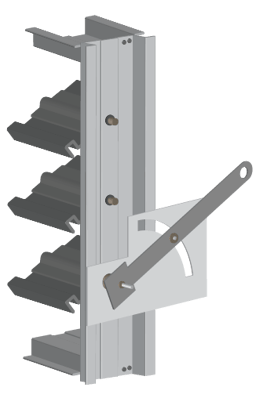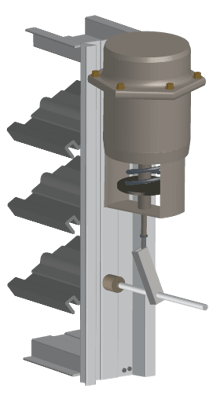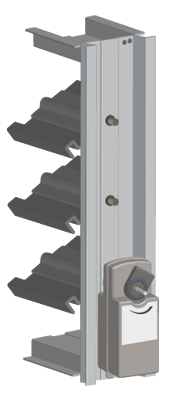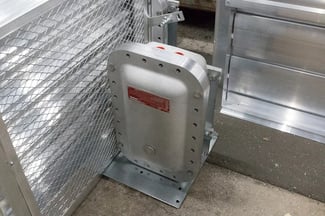Which type of actuator is best? It depends on what you need it for.
What are actuators?.jpg?width=400&height=267&name=Damper%20Accessories%20-%20Electric%20Actuator%20(Resize).jpg)
First, let's answer the question: what are actuators?
Actuators control the movement of adjustable blades on dampers and adjustable louvers. Actuators can be manually operated or automatically controlled, for two-position or modular action.
In other words, an automated actuator can move blades to one of two positions - usually fully open and fully closed - or adjust the position to any angle you want. Automated actuators can also help create a fully automated HVAC system.
For more on accessories and options, read these Newsstand articles:
- The Condenser: Extendables - Extensions for Damper Blade Shafts
- Options for Control Dampers
- Options for Louvers
- Damper Blades, A Primer
Manual Operation
A manual actuator is a cost-effective option, but it will require regular access to the damper and needs an operator to control the actuator.
Hand quadrants are the most common type of manual actuator. You must adjust these actuators by hand, like a lever. In fact, hand quadrants are reinforced levers installed on the driving axle of the damper. With the hand quadrant, operators can adjust the blades by pulling or pushing the lever.
These actuators are best suited for blades that open or close on occasion. Hand quadrants are the cheapest option, but they require access to the louver or damper being adjusted. They are not a good fit for dampers in ducts.
You may not be able to freely adjust the hand quadrant. Adjustable louvers are installed in or near a building's walls, making them difficult to access. In these situations, a manual actuator may not be your best option.
With automatic actuators, you don't need access the louver or damper.
Automatic Operation
Automatic actuators control blade movement through pneumatic action or with an electric motor. These are known as pneumatic actuators and electric actuators.
Pneumatic actuators use compressed air to move an enclosed piston up and down. This action is tied to the blades, adjusting them open or closed as the piston moves. These actuators can provide precise control for a low cost per actuator.
However, pneumatic actuators require a compressor system to generate compressed air and air lines to feed it into the actuators. Pneumatic actuators are cheap because of their straightforward design, but the compressor and air line systems are expensive to install. Older buildings may already have these systems installed. In that case, pneumatic actuators are the best option.
Most modern projects use electric actuators for their adjustable louvers and dampers.
 Electric actuators use small electric motors to control the adjustable blades, allowing for even greater precision than pneumatic actuators. Also, advances in technology have made electric actuators a cheaper and more effective option for automating adjustable louvers and dampers.
Electric actuators use small electric motors to control the adjustable blades, allowing for even greater precision than pneumatic actuators. Also, advances in technology have made electric actuators a cheaper and more effective option for automating adjustable louvers and dampers.
Electric actuators require an electrician for installation and for tying the actuator to the building's power. You should also consider this initial cost when weighing your options.
Once installed, these actuators can be connected to digital controllers for a fully autonomous HVAC solution. From the controller, actuators can be individually configured. This controller can adjust the blade positions of multiple dampers and louvers at once.
Although electric actuators have set-and-forget functionality, all actuators require regular inspection and maintenance to ensure their parts are in good condition.
Options for Actuators
Actuators can be customized for a specific situation. Adjustable louvers and dampers can also receive additional accessories to assist the actuator's actions. Below are a few of the options:
"Power Open - Spring Close": This option will open the damper/louver when power is applied to the actuator. Springs inside the actuator will force the damper/louver to close when power is removed. This is the standard action for most actuators and is required for UL Life Safety dampers.
"Power Close - Spring Open": The opposite of "Power Open - Spring Close". The actuator will close the damper/louver when power is applied, and the internal springs will open the damper when power is lost.
Jackshaft: A specialized shaft for synchronizing blades across multiple dampers. Jackshafts are typically installed behind the damper and control the blades' rotation through on-face linkage. The actuator will be connected to the jackshaft.
Jumper Bracket: A device that assists the movement of dampers and louvers connected as a multi-panel unit, often used with a jackshaft. The jumper bracket connects blades between adjacent sections, bridging the louver/damper panels together and synchronizing their blade movement. Jumper brackets assist the connected actuator by reducing the amount of torque required to open and close the blades.
Dual Position Indication (DPI) Switch: A device installed on actuators to show which position the blades are in at a given time. Some models of DPI switches can be customized to indicate different blade angles. Learn how they work in "Open and Closed".
.webp?width=500&height=334&name=DPI%20Switch%20-%20PK1200%20(Resize).webp) DPI switches can be part of the actuator or installed as a standalone unit. This picture shows a standalone DPI switch.
DPI switches can be part of the actuator or installed as a standalone unit. This picture shows a standalone DPI switch.
Most actuators have an integral DPI switch already installed, but you can also choose to have a separate DPI switch installed in the damper.
External DPI switches can monitor blade position and shaft rotation, as opposed to the integral DPI switch that only monitors blade position. External DPI switches can be important in diagnosing a mechanical failure in the damper.
Decisions, Decisions
It seems like electric actuators are the way to go: cheap to build, easy to set up, and highly automated.
However, there may be instances where a pneumatic actuator or a hand quadrant would work better for your needs.

The main cost comes from installing and maintaining the air compression systems. If you already have the airlines and compressor system in place, then pneumatic actuators are an easy decision.
Despite the advances in electric motors, pneumatic actuators still have a lower per-unit cost than electric actuators.
The cheapest option of all is the hand quadrant. If you have easy access to the damper or louver, and you don't need to adjust it often, then you may consider using a hand quadrant to adjust the blades.
Saving money is always a good thing, especially if you're building an HVAC system from the ground up. But a fully automated HVAC system, using electric actuators, may save you time and money overall. It all depends on what works best for your project.

Looking for control dampers? At Arrow United Industries, we build our dampers from the ground up to meet the needs of your project. Contact us today and let's work together on designing your HVAC system.
Electric actuators are common nowadays. Have you ever used pneumatic actuators in a project? Have you ever installed a manual actuator? Share your actuator stories in the Comments section. We want to hear from you!
Do you have a question on something we haven't covered here? MCDLG can help. Contact us by clicking on the button below.
.webp?width=91&height=70&name=MCDLG%20Logo%20(Resize).webp)
.webp)




